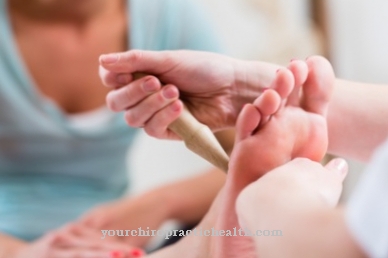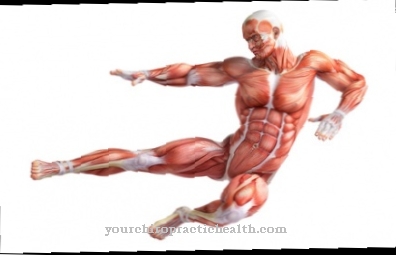Supination refers to a movement of the extremities that is part of running, jumping and other movements. If it is carried out correctly, the person concerned cannot be harmed. However, if the outward turn occurs at the wrong time, it takes too long or the runner has no control over the turn, e.g. the foot kinks outwards and can cause serious injuries. Athletes with excessive supination have an ineffective running style because the main load when rolling the foot is then on the outer toes and the cushioning is therefore insufficient.
What is supination?

Supination means "turned away position" and in arm supination refers to a sequence of movements with angled forearm and hand in which the palm is turned upwards so that the thumb points outwards. The ulna and radius are then parallel to each other. The forearm muscles on the radius and ulna, such as the supinator and the brachioradialis muscle, are involved in the rotation. The joints stressed are the proximal and distal radius and ulna joint. If the supination is performed with the arm hanging, the palm is moved forward.
In foot supination, the outer instep is pressed down instead of inward so that the foot rolls over its outer edge. The inside of the foot is directed upwards. The heel remains in its normal position. The big toe becomes curved. The main muscles involved in foot supination are called the twin calf muscles and clod muscles.
In addition, the posterior and anterior tibial muscles, the long big toe flexor and the long toe flexor also contribute to the movement. The joints involved are called Articulatio subtalaris and Articulatio talocalcaneonavicularis.
Supination also describes the excessive outward rotation of the foot and hand. The misalignment is also known as under-pronation. About 2 to 10 percent of runners and joggers have a more or less pronounced supination. If you are not sure whether you are executing the movement correctly when running, you should occasionally examine the soles of your shoes: If the outer edges and the ball of the foot are badly worn, the person affected will suffer from excessive supination. There are also cases of supination where only one foot is affected.
Function & task
If done correctly, supination is a normal arm or foot movement that can be incorporated into other more complex processes. However, excessive supination or under-pronation can sometimes have dire consequences for the person concerned.
When running, the supination consists of the three movements plantar flexion, inversion and adduction. In plantar flexion, the tip of the foot points downwards, in inversion the arch of the foot is raised and pressed with the outside down. Adduction means that the tip of the foot is turned inwards.
If the runner makes a jump, he puts the outer edge of the longitudinal arch on the floor, whereby the jump is only insufficiently cushioned. The lack of cushioning is passed on to all joints, which has different effects depending on body weight.
In order not to deteriorate your condition, to prevent premature fatigue and possible injuries and accidents, it is advisable to buy the right running shoe in good time. For lighter cases of supination, a neutral shoe with good cushioning is suitable. The latter is particularly important as it has to replace the missing natural cushioning. Neutral shoes are actually designed for runners with normal heel motion, but can also be used by users with excessive supination if they do not have a pronation support. They should be cut on curved groins, have a reinforced toe area and good lateral guidance. For a better grip, it is also advisable to only buy a model with a robust upper material. If the supination is more pronounced, a special cushioning shoe is required.
Illnesses & ailments
Excessive supination usually occurs with high arches and a very rigid arch of the foot. Under-pronation can be congenital or acquired during life. It is congenital in combination with bow legs, unequal lower leg muscles or a family history.
An extreme example of supination is the genetically determined clubfoot, in which the excessive supination also occurs together with equinus, archesus and other deformations. In addition, the misalignment can be caused by previous ankle injuries, which can be compensated with a relieving posture. Foot muscle paralysis, damaged nerves, weak ligaments and painful pressure points on the balls of the feet and toes can also lead to cramping and supination.
Under-pronation puts extreme stress on the ankles themselves and their outer ligaments: if the ankle is severely twisted, they are overstretched and can even tear (torn ligament). Sprained ankles can also result.
The hip joint, spine and knee are also overstrained without additional cushioning. Excessively stressed shins can break or periosteum inflammation and shin splints can occur.
Excessive supination can also lead to inflamed Achilles tendons, meniscus problems, and supination trauma. This is serious damage caused by overstretching tendons, ligaments and the ankle joint capsule.
Arches foot and supination, if they are not too pronounced, can also be corrected with foot gymnastics, frequent barefoot walking and the appropriate footwear. If these measures do not help to strengthen the foot muscles, the only thing left for the person affected is the surgical correction of the arch of the foot.













.jpg)

.jpg)
.jpg)











.jpg)